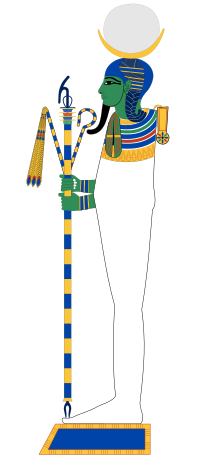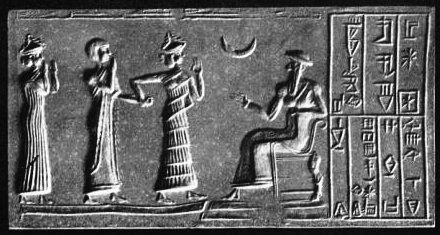http://en.wikipedia.org/wiki/Khonsu wrote:

 [c]Khonsu is typically depicted as a mummy with the symbol of childhood,
[c]Khonsu is typically depicted as a mummy with the symbol of childhood,
a sidelock of hair, as well as the menat necklace with crook and flail.
He has close links to other divine children such as Horus and Shu.
He is sometimes shown wearing a falcon's head like Horus,
with whom he is associated as a protector and healer,
adorned with the sun disk and crescent moon.[/c]
<<Khonsu (alternately Chonsu, Khensu, Khons, Chons or Khonshu) is an Ancient Egyptian god whose main role was associated with the moon. His name means "
traveller" and this may relate to the nightly travel of the moon across the sky. Along with Thoth he marked the passage of time. Khonsu was instrumental in the creation of new life in all living creatures. At Thebes he formed part of a family triad with
Mut as his mother and Amun his father.
Khonsu is mentioned in the
Pyramid Texts (2686 BC – 2181 BC) and
Coffin Texts (ca. 2181-2055 BC), in which he is depicted in a fierce aspect, but he does not rise to prominence until the New Kingdom (ca. 1550–1070 B.C.), when he is described as the "Greatest God of the Great Gods". Locations of
Khonsu's cult were Memphis, Hibis and
Edfu. Most of the construction of the temple complex at
Karnak (c. 1550–c. 1292 BC) was centered on Khonsu during the Ramesside Period. His temple at Karnak is in a relatively good state of preservation, and
on one of the walls is depicted a cosmogeny in which Khonsu is described as the great snake who fertilizes the Cosmic Egg in the creation of the world.
As the god of light in the night, Khonsu was invoked to protect against wild animals, increase male virility, and to aid with healing. It was said that when Khonsu caused the crescent moon to shine, women conceived, cattle became fertile, and all nostrils and every throat was filled with fresh air. Khonsu can also be understood to mean king's placenta, and consequently in early times, he was considered to slay the king's (i.e. the pharaoh's) enemies, and extract their innards for the king's use, metaphorically creating something resembling a placenta for the king. This bloodthirsty aspect leads him to be referred to, in such as the Pyramid texts, as the (one who) lives on hearts.
Khonsu is typically depicted as a mummy with the symbol of childhood, a sidelock of hair, as well as the menat necklace with crook and flail. He has close links to other divine children such as Horus and Shu. He is sometimes shown wearing a falcon's head like Horus, with whom he is associated as a protector and healer, adorned with the sun disk and crescent moon. In art, Khonsu was depicted as a man with the head of a hawk, wearing the crescent of the new moon subtending the disc of the full moon. He was sometimes pictured on the back of a goose, ram, or two crocodiles. His sacred animal was the
baboon, considered a lunar animal by the ancient Egyptians.>>
 Super Moon vs Micro Moon
Super Moon vs Micro Moon



